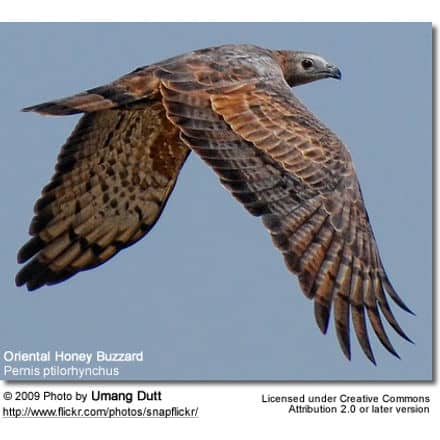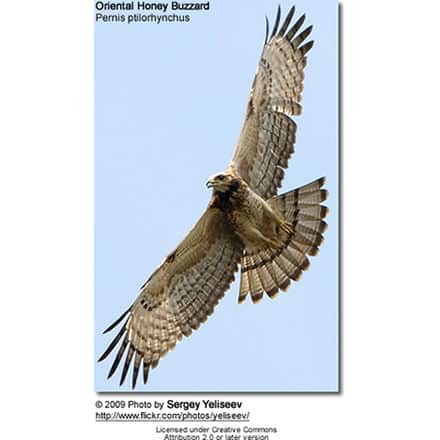Oriental Honey Buzzard
The Oriental Honey Buzzards, Pernis ptilorhynchus, is a bird of prey in the family Accipitridae which also includes many other diurnal raptors such as kites, eagles and harriers. This species is also known as the Oriental Honey-buzzard and Crested Honey Buzzard.
Despite its name, this species is not related to Buteo buzzards, and is taxonomically closer to the kites.
Distribution / Range
It breeds in Asia from central Siberia east to Japan. It is a summer migrant to Siberia, wintering in tropical southeast Asia. Elsewhere it is more-or-less resident.
The Oriental Honey Buzzards breeds in woodland and is inconspicuous except in the spring when the mating display includes wing-clapping.
The display of roller-coasting in flight and fluttering wings at the peak of the ascent are characteristic of the genus Perni
Description
It appears long-necked with a small head, and soars on flat wings. The head lacks a strong supraciliary ridge giving it a very un-raptor-like facial appearance.
It has a long tail and a short head crest. It is brown above, but not as dark as Honey Buzzard, and paler below. There is a dark throat stripe.
It is larger and longer winged than its western counterpart, Honey Buzzard, Pernis apivorus.
Unusually for a large bird of prey, the sexes can be distinguished:
The male has a blue-grey head, while the female’s head is brown. She is slightly larger and darker than the male. The male has a black tail with a white band, whilst the female resembles female Honey Buzzard.

Mimicry
It has been suggested that the similarity in plumage between juvenile Oriental Honey Buzzard and the Spizaetus hawk-eagles has arisen as a partial protection against predation by larger raptors. The eagles have stronger bills and talons and are likely to be less vulnerable than the Pernis species.
Similar mimicry is shown by the juveniles of the European Honey Buzzard, which resembles the Common Buzzard. Although the Northern Goshawk is capable of killing both species, it is likely to be more cautious about attacking the better-protected Buteo species.
Diet / Feeding
It is a specialist feeder, living mainly on the larvae and nests of wasps, although it will take other small insect prey such as cicadas.
Buzzards … Birds of Prey … The Sport of Falconry



